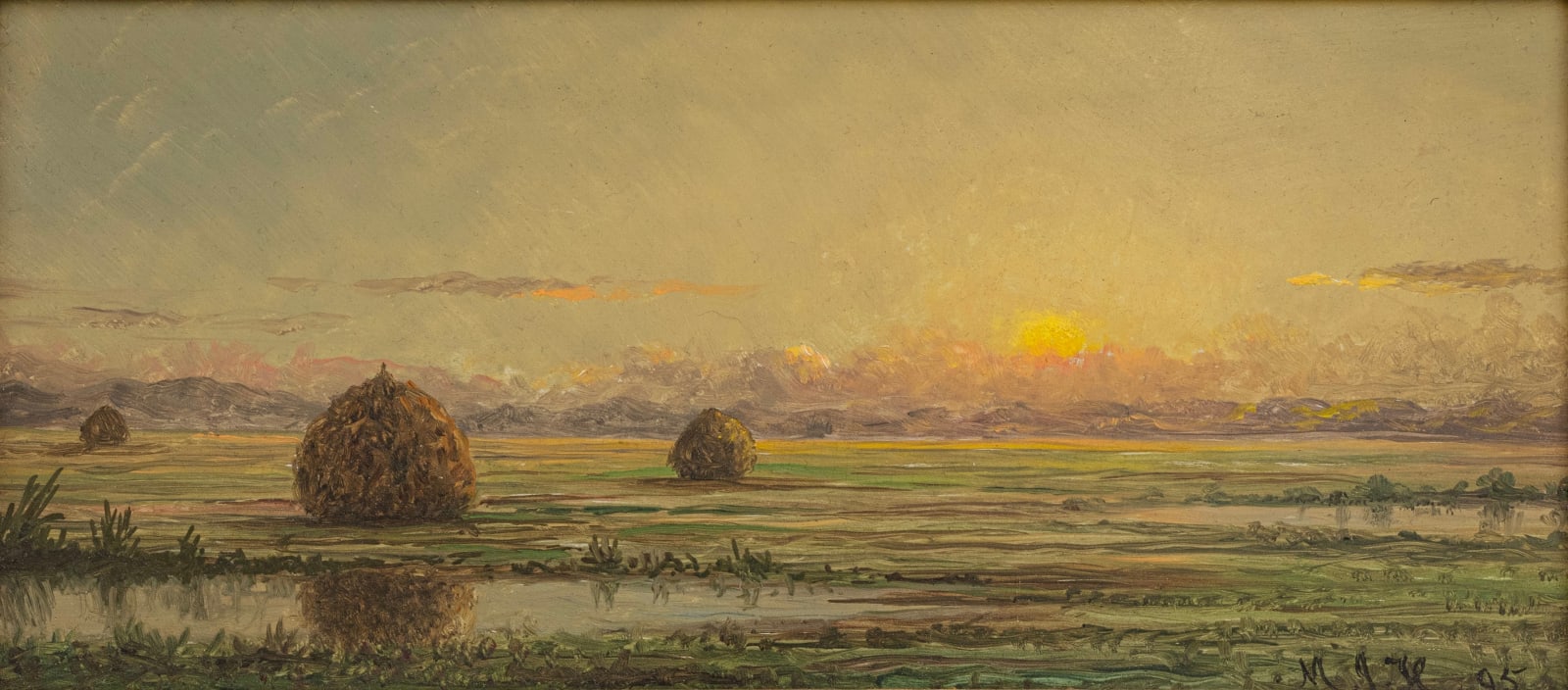-
Artworks
Martin Johnson Heade
Sunset—A Sketch, 1895Oil on board6 x 12 inches
15.2 x 30.5 cmSigned and dated at lower right: M.J.H. '95Sunset—A Sketch belongs to a long series of haystack scenes that portray Martin Johnson Heade's favorite marshes in the adjoining towns of Newbury and Newburyport, Massachusetts. The composition and coloration...Sunset—A Sketch belongs to a long series of haystack scenes that portray Martin Johnson Heade's favorite marshes in the adjoining towns of Newbury and Newburyport, Massachusetts. The composition and coloration make the present work a superb example that illustrates Heade's original approach to capturing the slower rhythms of nature—exaggerated horizontality with a low horizon line, the meandering river leading the eye into the composition, and the haystacks in varying sizes dotting the horizon. Heade believed the marsh held universal meaning, especially at twilight. Theodore Stebbins, art historian and author of the Heade catalogue raisonné observed, "he frequently depicted the northeastern marsh or the southern swamp at sunset: these are quiet, dark pictures which speak of loneliness and invite contemplation of the beauty of nature, the smallness of human beings, the inevitable end of the day and of life." [1] Heade's quiet, contemplative scene illustrates a departure from the grandeur of untouched nature favored by the Hudson River School painters.
Most of Heade's haystack pictures are not site-specific—the artist was more interested in capturing the unique characteristics of marsh life from memory than the exact spot. For Heade, coastal salt marshes represent the ideal landscape subject, and he made capturing the wetlands in various atmospheric conditions the focus of his practice. Heade's continued investigations into the temporal and atmospheric effects on a repeated subject parallel the haystacks of Claude Monet's celebrated "Haystacks" or "Wheatstacks" series, done simultaneously in France. Sunset—A Sketch reveals Heade's significant influence on the evolution of painting in the following century. The haystack scenes embody the essence of the Luminist movement and continue to captivate viewers with their exploration of light, color, and the beauty of the natural world.
[1] Theodore Stebbins, Jr., Karen E. Quinn, and Janet L. Comey, The Life and Work of Martin Johnson Heade, New Haven: Yale University Press, 2000, p. 118.
Provenance
The artist;
[Frederick Mont and Victor Spark, New York};
Ernest Rosenfeled, New York;
[Sale: Parke-Bernet Galleries, New York, November 18, 1965, lot 57]; to
Edward E. White, New York; by descent to
Private collection;
[Sale: Sotheby's, New York, May 24, 2006, lot 1]; to
Dorrance (Dodo) H. Hamilton, 2006 to 2018; to
[Sale: Freeman's, Philadelphia, April 29, 2018, lot 21]; to
Private collection, 2018 until the present
Exhibitions
Butler Museum of American Art, Youngstown, Ohio, 1958-65Literature
Theodore E. Stebbins, Jr., The Life and Work of Martin Johnson Heade: A Critical Analysis and Catalogue Raisonné, New Haven and London: Yale University Press, 2000, p. 277, no. 303, illus., p. 165
Theodore E. Stebbins, Jr., The Life and Works of Martin Johnson Heade, New Haven and London: Yale University Press, 1975, p. 166, no. 355, illus., p. 165
2of 2
Subscribe to our mailing list to receive updates from the gallery
* denotes required fields
We will process the personal data you have supplied in accordance with our privacy policy (available on request). You can unsubscribe or change your preferences at any time by clicking the link in our emails.

